
(Flexor Tendinitis)
|
| What is it? |
-
Trigger finger is a type of tendinitis which develops in the tendons which
bend the fingers. It is a common problem because of the way that the hand
is made, which may be a little different than you would suspect.
There are no muscles in the fingers themselves. We actually move our fingers
by remote control. Muscles in the forearm are connected to the finger bones
by smooth, flexible strings, called tendons. The muscles pull on the tendons,
which then bend the finger joints.
| The flexor tendons are smooth, flexible, thick strings - they look
a bit like clothesline rope. They work like a bicycle brake cable to bend
your fingers, sliding in and out of the finger as it straightens and bends. |
|
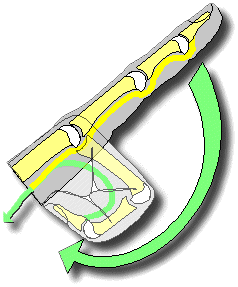 |
-
This arrangement allows the fingers to be slender, yet have all the strength
of the large muscles in the forearm.
|
| What caused it? |
-
Tendon swelling (tendinitis) results from a person's own tendency to collect
fluid around their tendons and joints. This may be aggravated by repetitive
or strenuous activities. When the tendons which bend the fingers
(the flexor tendons) become irritated, they can cause pain, swelling, and
stiffness. Tendon swelling interferes with the normal movement of the tendons
and can cause the finger to and click, catch ("triggering") or lock in
position.
| The tendons which bend the fingers are prone to irritation and sticking
in front of the joint in the palm at the base of the finger: |
|
 |
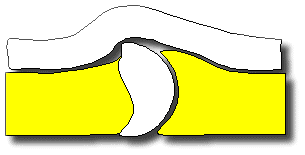
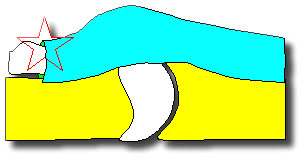 |
| The tendons enter a tube (the tendon sheath) at this joint. The sheath
runs the length of the finger, but the problem area is just at the entrance,
where the restraint is the most snug. This is typically where the worst
inflammation and irritation occurs. |
|
| What can you do to help? |
-
Ice for five to fifteen minutes at a time on the area which is most swollen
and tender.
-
"Over the counter" non-steroidal anti inflammatory medication (NSAID),
such as aspirin, ibuprofen, naprosyn, or ketoprofen. Check with your pharmacist
regarding possible side effects and drug interactions.
-
Avoid activities which involve a sustained grip. Hold off on the use of
grip strengthening devices or exercises involving repetitive squeezing
- these put stress on the irritated tendon.
-
If fingers bend and lock during the night and are painful to straighten
in the morning, it may be helpful to wear a splint to keep them straight
while sleeping. One way to do this is to use a wrist support splint as
shown below: A wrist splint designed to be worn on the opposite hand may
be worn with the forearm end turned out to form a palm sided support for
the fingers. This may be helpful as an interim measure.
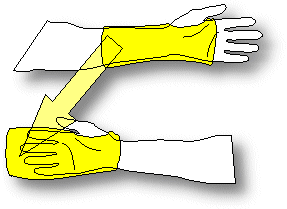
|
| What can a therapist do to help? |
-
Help identify aggravating activities and suggest alternative postures.
-
Massage, heat, ice and other treatments aimed at making the area more comfortable.
-
Sometimes a custom splint which limits finger bending can help.
|
| What can a doctor do to help? |
-
Confirm that this actually is the problem.
-
Prescribe stronger NSAID medication or cortisone type medication.
-
Prescribe hand therapy and/or a custom prescription splint.
-
Give a cortisone shot into the sore area. Usually, no more than two shots
are given into one finger because more may lead to complications, such
as tendon rupture.
-
Perform surgery.
| Surgery usually involves releasing or enlarging the tight area of the
tendon sheath where the tendon is binding. |
|

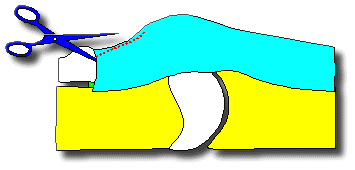 |
| One treatment is simply to cut the sheath open and leave it that way.
It heals back, but with more room - like letting out a pair of pants. This
type of operation is usually done as an outpatient procedure under local
anesthesia, after which a soft gauze bandage is worn for about a week. |
|
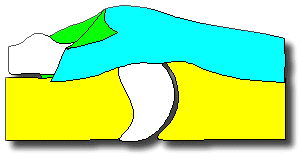
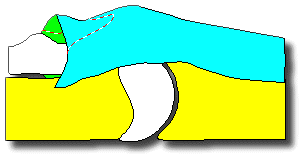 |
|
| How successful is treatment? |
-
Cortisone shots usually provide relief, although this is temporary nearly
half of the time.
-
Surgery provides permanent relief from locking and triggering in the great
majority of patients.
-
Swelling, stiffness, aches and pains in the fingers may well be due to
other problems, and may persist to some extent following any form of treatment.
Many patients with trigger fingers also have a tendency to have swelling,
stiffness and soreness of the moving parts of their hands, and that is
not changed by surgery.
-
With this in mind, the great majority of patients are improved with appropriate
treatment.
|
| What happens if you have no treatment? |
-
It depends on how much it is bothering you - it really is a quality of
life issue. This is not a problem which can spread to other parts of your
body. Some people have triggering which resolves over a period of months.
-
Other than persistent pain and stiffness, the additional problem which
may develop is a permanent partial bend of the middle joint of the finger.
This is more likely the longer triggering has been going on.
-
The main reason to do surgery is to relieve pain. Some people will have
a mild problem which flares up from time to time, and treat it themselves
or ignore it. Others will have a severe problem which prevents them from
doing many things with their finger, and feel that they have no choice
but to have surgery.
|
|
| |